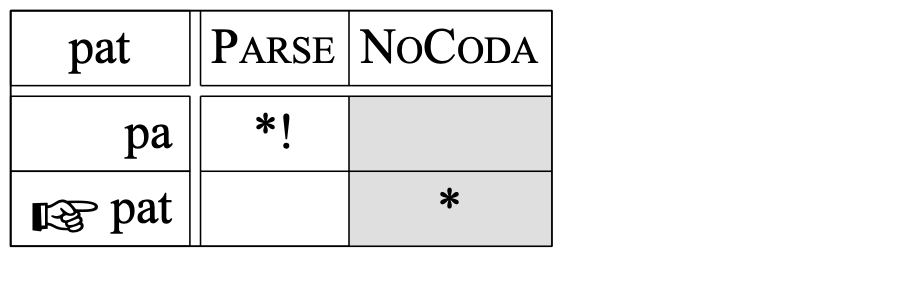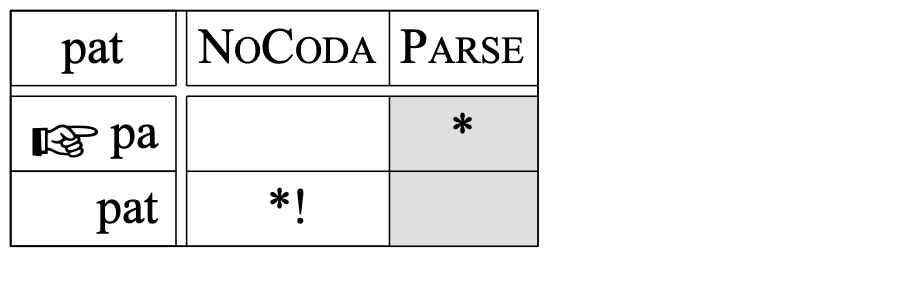|
OT learning 2.6. Variable output
|
|
Each time you press (Command-2), which invokes the command Evaluate (noise 2.0) from the Edit menu, you will see the disharmonies changing. If the distance between the constraint rankings is 10, however, the winning candidates will very probably stay the same.
So starting from the NOCODA example, we edit the rankings of the constraints again, setting the ranking value of PARSE to 88 and that of NOCODA to 85. If we now press Command-2 repeatedly, we will get [pat] in most of the cases, but we will see the finger pointing at [pa] in 14 percent of the cases:
-
| ranking value | disharmony | plasticity |
-
| PARSE | 88.000 | 87.421 | 1.000 |
-
| NOCODA | 85.000 | 85.585 | 1.000 |

but
-
| ranking value | disharmony | plasticity |
-
| NOCODA | 85.000 | 87.128 | 1.000 |
-
| PARSE | 88.000 | 85.076 | 1.000 |

As a more functionally oriented example, we consider nasal place assimilation. Suppose that the underlying sequence /an+pa/ surfaces as the assimilated [ampa] in 80 percent of the cases, and as the faithful [anpa] in the remaining 20 percent, while the non-nasal stop /t/ never assimilates. This can be achieved by having the articulatory constraint *GESTURE ranked at a short distance above *REPLACE (n, m):
"ooTextFile"
"OTGrammar 2"
decisionStrategy = <OptimalityTheory>
leak = 0.0
3 constraints
"*G\s{ESTURE}" 102.7 0 1
"*R\s{EPLACE} (n, m)" 100.0 0 1
"*R\s{EPLACE} (t, p)" 112.0 0 1
0 fixed rankings
2 tableaus
"an+pa" 2
"anpa" 1 0 0
"ampa" 0 1 0
"at+ma" 2
"atma" 1 0 0
"apma" 0 0 1
You can create this grammar with Create place assimilation grammar from the New menu. In the editor, it will often look like follows:
-
| ranking value | disharmony | plasticity |
-
| *REPLACE (t, p) | 112.000 | 109.806 | 1.000 |
-
| *GESTURE | 102.700 | 102.742 | 1.000 |
-
| *REPLACE (n, m) | 100.000 | 101.044 | 1.000 |


If you keep the Command-2 keys pressed, however, you will see that the tableaus change into something like the following in approximately 20 percent of the cases:
-
| ranking value | disharmony | plasticity |
-
| *REPLACE (t, p) | 112.000 | 113.395 | 1.000 |
-
| *REPLACE (n, m) | 100.000 | 103.324 | 1.000 |
-
| *GESTURE | 102.700 | 101.722 | 1.000 |


We see that /at+ma/ always surfaces at [atma], because *REPLACE (t, p) is ranked much higher than the other two, and that the output of /an+pa/ is variable because of the close rankings of *GESTURE and *REPLACE (n, m).
If you try this with a Harmonic Grammar or in Linear OT, you will see the same kind of variation. Although in HG, e.g. in Smolensky & Legendre (2006), the variation is usually obtained at the candidate level, namely by giving each candidate a probability proportional to exp(harmony/temperature), in our version of HG the variation comes about at the constraint level, namely by the noise that is temporarily added to the ranking of each constraint at evaluation time.
Links to this page
© ppgb 20070725






